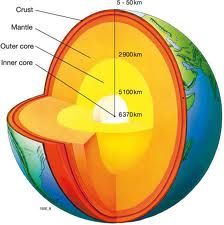Overview
Whether we’re at school or at work, the one thing we tend to take for granted is our home. Not our physical houses, but our Home – the Earth. So let’s take some time to learn more about our amazing Home and the many layers to it. The Earth has a radius of 6,378 kilometres (3,963 miles) measured from the centre of its core all the way to the ground (where we stand). Between the 6,378 kilometres, the Earth can be fundamentally broken down into 3 main parts; the Crust, the Mantle, and the Core. Let’s start our exploration with the Crust.
 The Crust
The Crust
The Crust is the outermost layer of the Earth. The crust is completely solid and made up of rocks and various kinds of minerals. It is actually much thinner than you might expect it to be, as it only makes up roughly 1% of the Earth’s total volume. With a depth of 40 kilometers (or 25 miles) it can generally be broken down into two distinct types. The first type of crust is a thicker, continental crust and the second being a thinner oceanic crust.
Continental Crust
The continental crust is primarily composed of many different types of granites. Aluminum and silicon are the most abundant elements found in this type of crust, hence, geologists also refer to the continental crust as “sial”. Sial stands for silicates and aluminum respectively. In comparison to the oceanic crust, the continental crust is much older in age.
Oceanic Crust
The oceanic crust extends beneath the ocean floors by approximately 5-10 kilometers (3-6 miles). This sort of crust is mainly composed of different types of basalts. The most abundant elements that make up the oceanic crust are silicon and magnesium; as a result, geologists refer to the oceanic crust as “sima”. Sima stands for silicates and magnesium respectively. The oceanic crust is much younger in age in comparison to continental crust because of the process of subduction. Due to plate tectonics, many areas where two or more oceanic plates can cause one plate to sink beneath the other; grinding away at both plates. As a result, the oceanic plates tend to erode and recycle often leading them to always be much younger in age.
The Mantle
Venturing further down into the Earth, after the crust, we have the mantle. The mantle is a mostly-solid portion of the subsurface of the Earth which has a depth of about 2,900 kilometers (1,802 miles). In comparison to the measly 1% of Earth’s volume that the crust makes up for, the mantle accounts for a staggering 82% of the Earth’s total volume. The rocks that commonly make up the mantle are silicates. Some silicates (which are compounds that have both silicon and oxygen molecules) that can be found in the mantle are; olivine, garnet, and pyroxene. Another common type of compounds/elements found in the mantle are; magnesium oxide, iron, aluminum, calcium, sodium, etc. The expected temperature in the mantle falls between the range of 1000°C (1832°F) to 3700°C (6692°F).
The Core
Finally, we’ve arrived at the Core. The core can be broken down into two sections; the Outer Core and the Inner Core.
The Outer Core
The outer core is the portion of the core that is the closest to the mantle of the Earth. The outer core has a thickness of 2,200 kilometers (1,367 miles) and is composed of liquid iron and nickel. The alloy that is formed, NiFe, has a very high temperature. The outer core has a temperature range of 4,500°C (8,132°F) to 5,500°C (9,932°F). The liquid metal of the outer core has a very low viscosity, meaning that it deforms very easily and is malleable.
The Inner Core
The inner core is a hot, dense sphere composed of iron. The sphere has a radius of about 1,220 kilometers (758 miles) in size.The temperature of the inner core is approximately 5,200°C (9,392°F). In comparison to the outer core, on average the inner core is much hotter than the outer core. 5,200°C (9,392°F) is far beyond the melting point of iron. Despite that, you might expect the inner core to be liquid like the outer core but due to the inner core’s intense pressure (and the entire rest of the planet and its atmosphere) the iron is prevented from melting. In short, the pressure and density are simply too great for the iron atoms to change state to a liquid. Because of these uncommon characteristics, most scientists prefer to interpret and understand the inner core not to be solide by as plasma.
Another unique characteristic of the inner core is that it rotates eastward, like the surface. The inner core makes a rotation about every 1,000 years. The Earth’s magnetic field is also theorized to be as a result of the inner cores rotation




